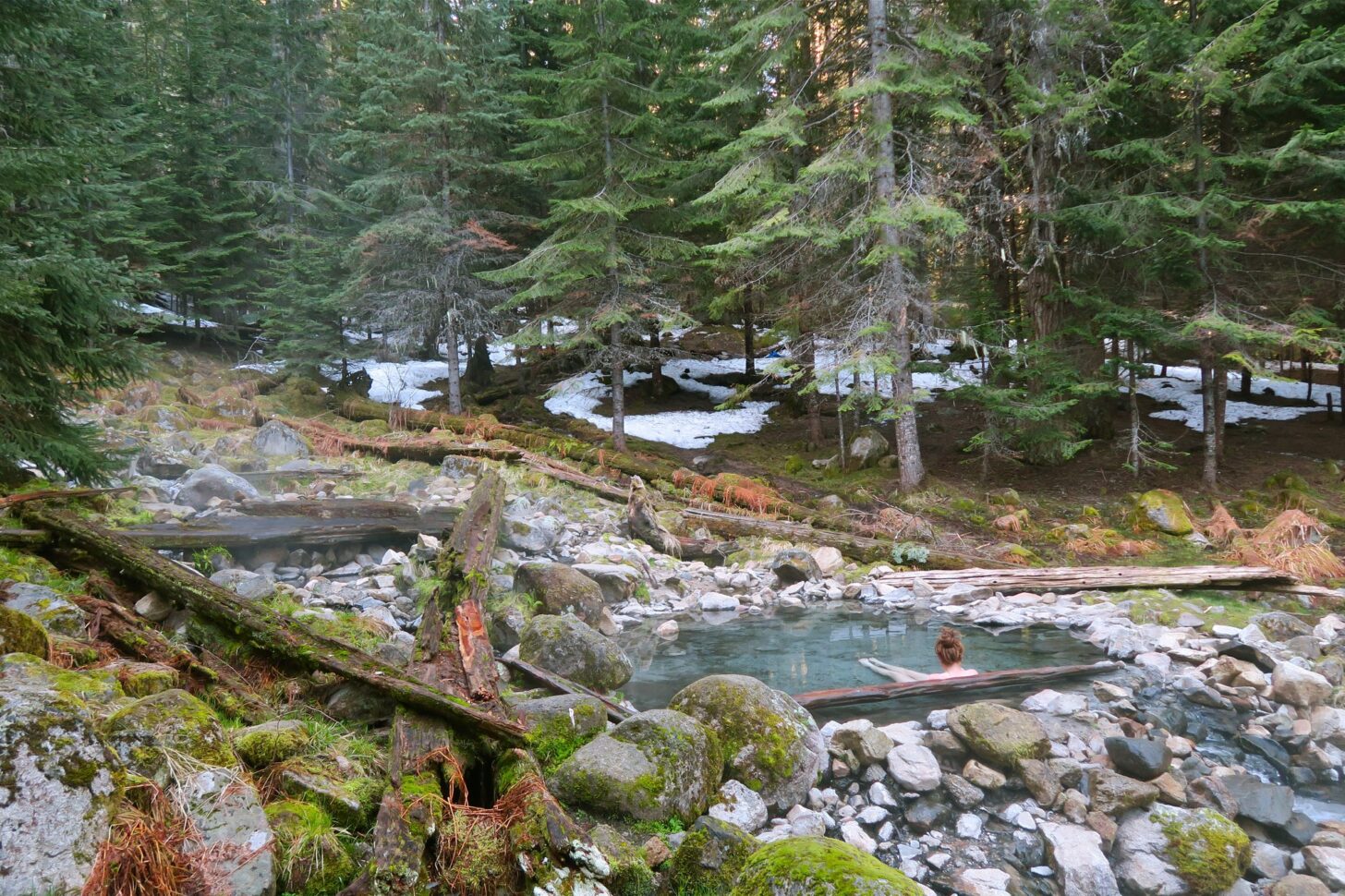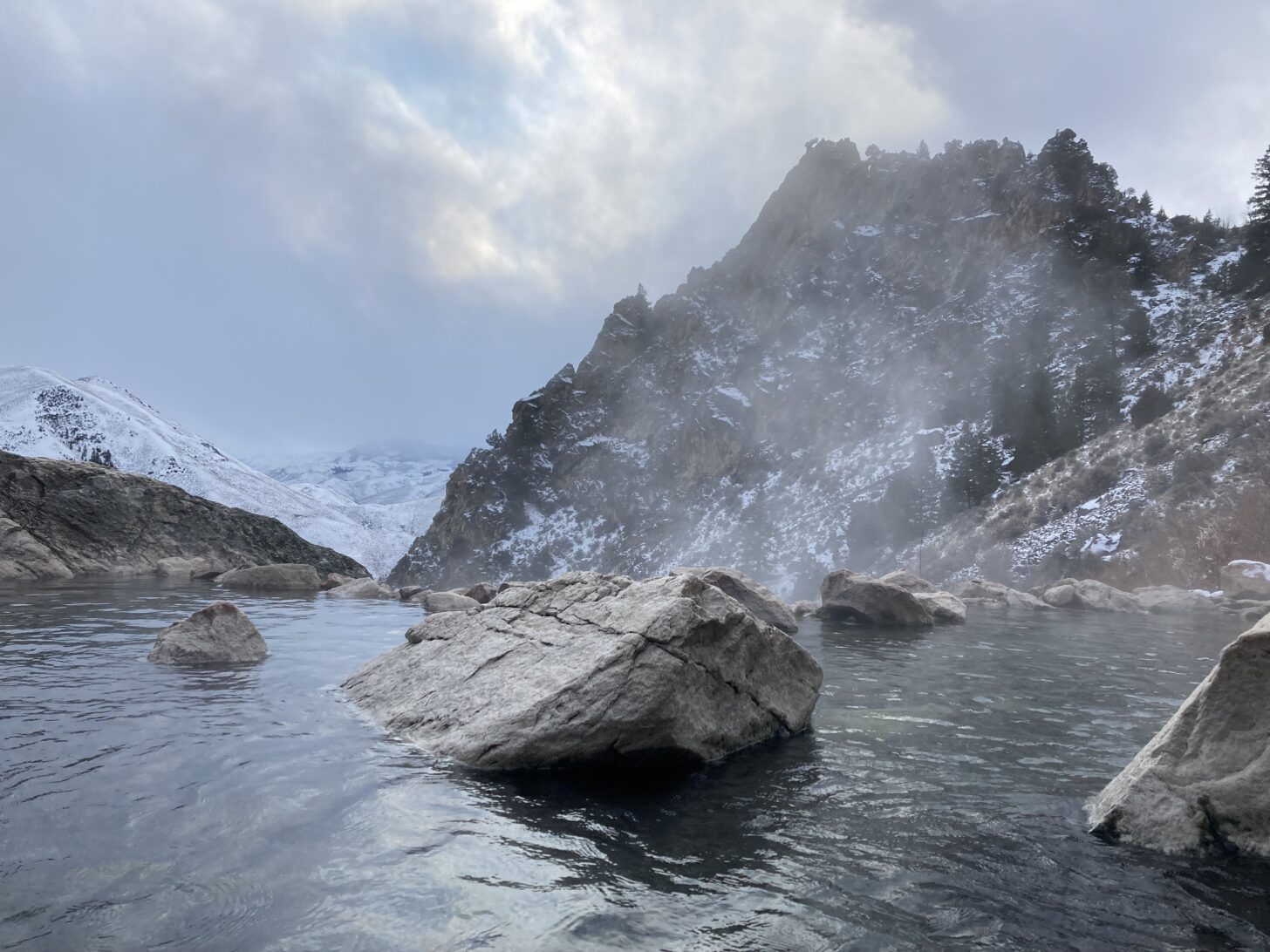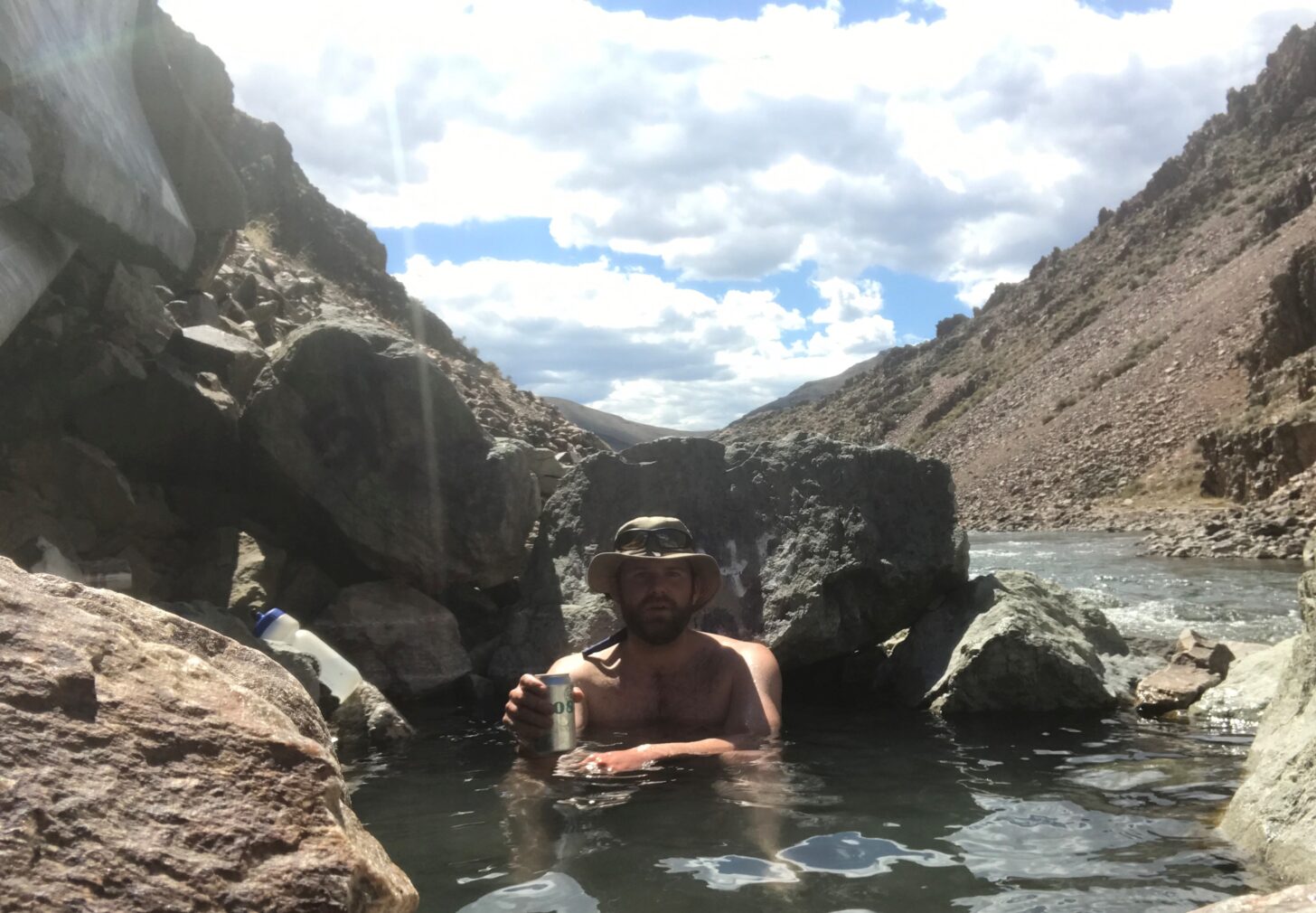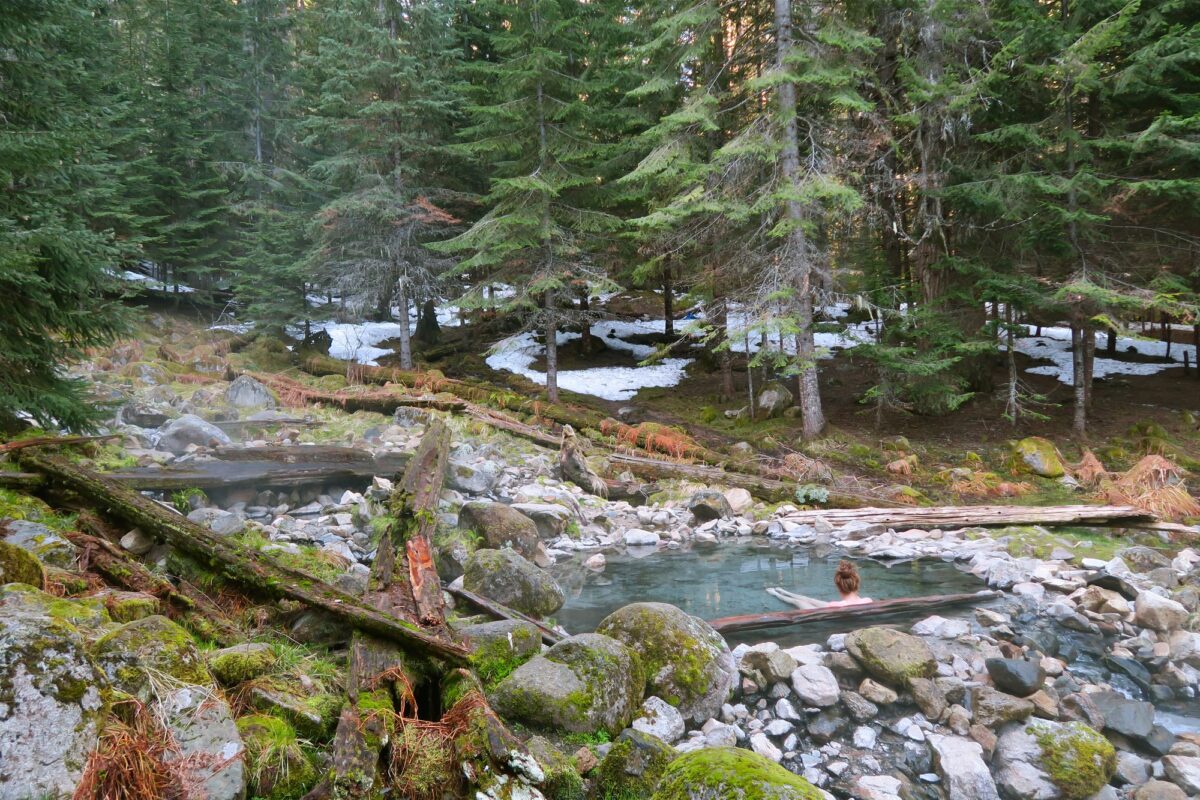Introduction
This article uses the current Seven Principles of Leave No Trace (LNT) to explore best practices for minimal impact camping near hot springs. These principles are not strict, inviolable rules – aside from one or two involving waste disposal. Instead, they inform sound decision-making. As with many aspects of ultralight backpacking, the exact applications of LNT principles involving hot springs sometimes require exercising judgment informed by the science behind the principles.

An increasingly popular backcountry destination
With the number of people recreating on public lands increasing significantly in the last few years, anecdotal evidence points to a proportionate increase in the use of hot springs on public lands. Some of the most popular hot springs, like Conundrum Hot Springs in Colorado’s Maroon Bells-Snowmass Wilderness, now require permits to minimize the impacts. Land management agencies are considering additional fees to help pay “for restoration, additional ranger field and visitor center presence, trail maintenance and improving user experience.”
Guidebooks have helped people discover backcountry hot springs for decades. Combined with social media and articles highlighting hikes to hot springs, there are more ways than ever for people to discover one of nature’s most sublime pleasures. While many of these resources provide information about access to hot springs, they sometimes lack guidance about rules and regulations, basic etiquette, and low-impact visitation techniques.
At developed hot springs accessible by vehicle, there is often infrastructure ranging from outhouse and trash cans to full-blown resorts. Backcountry hot springs often have few, if any, amenities designed to minimize the impacts of visitor use. Given the unique and often ecologically sensitive attributes of hot springs, backpackers must exercise the appropriate amount of responsibility and consideration to minimize impact. By doing so, they will ensure that these magical geothermal features remain ecologically viable – and that future soakers can enjoy as comfortable and natural an experience as possible.
Some precautions when visiting hot springs are common sense, like not bringing glass bottles, whereas others are more nuanced. By discussing each Leave No Trace principle and its relationship to recreating at backcountry hot springs, we hope to provide a useful outline to help hikers and backpackers enjoy themselves responsibly.
The seven principles of Leave No Trace are:
- Plan Ahead and Prepare
- Travel and Camp on Durable Surfaces
- Dispose of Waste Properly
- Leave What You Find
- Minimize Campfire Impacts
- Respect Wildlife
- Be Considerate of Other Visitors

Why trust us?
In preparation for this article, I reviewed the published information from the Leave No Trace Center for Outdoor Ethics and other articles that focused on minimizing the environmental impact at hot springs. I also corresponded with JD Tanner, Director of Education and Training at Leave No Trace, for additional insight. Finally, I tapped into my experience practicing Leave No Trace skills while visiting backcountry hot springs. This first-hand knowledge allows me to illustrate certain approaches and provide first-hand observations.
Plan ahead and prepare
Knowing as much as possible about trail conditions and the infrastructure (i.e., designated campsites, outhouses, etc.) en route to and at your destination are key components to a successful trip. Researching regulations, such as group size limits, fire bans, permit needs, and restrictions on camping too close to the hot springs, for example, is also essential.
You can also consider what items might make you more comfortable during your visit. I’ve found that packing in a small microfiber towel for drying off is usually a good call. At particularly rocky hot springs, it can be nice to have a small section of closed-cell foam to sit on, especially if it’s a hotter hot spring and you’ll frequently be taking short breaks from soaking to cool off.
Making calls to the land management agency and perusing information online, such as trip reports, can tell you how crowded the hot spring might be. This basic research might lead you to time your trip differently or at least temper your expectations for a solitary soak. If you find out that the hot spring you’re so eager to visit appears to be mobbed every weekend in the summer, you have some options. “Planning to visit these sites during less popular times of the year is highly encouraged,” said JD Tanner at Leave No Trace. “Checking out less visited hot spring sites would be a great alternative as well.”

On the not-so-pleasant side, your research might make you aware of issues at the hot springs you plan to visit – like the possible presence of “brain-eating amoeba”. In this example, it’s easy to mitigate exposure by not putting your head underwater. But you have to know about the danger to avoid it! That’s why research is so important!
Learn more about trek planning in Backpacking Light’s comprehensive Trek Planning Masterclass – free for Unlimited Members.
Travel and camp on durable surfaces
Hot springs are popular destinations, so many of them have well-defined and sustainable trails that reach them. Some might have multiple side trails branching from the main trail. These side trails can require scouting to choose the one with the least impact. Trails that go straight down a stream bank to hot springs are often erosion-prone but are sometimes unavoidable. Most hot springs have heavily-impacted campsites nearby. As long as they meet the criteria set by the land management agency, these sites are a better choice than making a new campsite in a previously unimpacted area. I’ve found that – somewhat counter-intuitively – it is usually more ideal to choose the campsite furthest from the hot springs. Not only is this in accordance with LNT guidelines about camping 200 feet or more from water sources, but it also provides you with more seclusion. You don’t have folks wandering through your campsite to get to theirs; if there’s a louder group in the pool, you’re out of earshot, and you don’t have your campsite on display to soakers.

National parks with designated campsites near hot springs (a depressingly scarce commodity, and permits for these can be competitive) are perhaps the gold standard of low-impact backcountry camping at hot springs. Camping is concentrated in a specific location, and outhouses make waste management during extended stays easier.
JD Tanner with Leave No Trace notes that information gained during the planning stage can help with campsite selection. “Contact the land managers to find out if it is permitted to camp around or near the springs first. If it is permitted, the land manager will likely give specifics on where to camp,” he said. “If they don’t, and there are no designated sites, then camp at least 200 feet away from the water and trails. Always be prepared to pack out trash no matter where you camp.”
Dispose of waste properly
Encountering improperly disposed of human waste near a hot spring is one of the most disgusting backcountry experiences a person can have. I speak from experience. Short of stepping on broken glass, it is perhaps the quickest way to ruin the sense of serenity, rejuvenation, and bliss that accompanies a soak. With most backcountry hot springs lacking outhouses, soakers must travel an appropriate distance – at least 200 feet – from the spring to conduct bowel-related business. Once far enough away, soakers should properly bury the deposit (click here for general LNT cat hole advice). The other option – arguably a better one at hot springs – is to use a waste disposal bag. Plan accordingly and bring a trowel, WAG bag, or whatever else you might need to ensure that your human waste doesn’t contaminate the water – or someone’s foot.

Leave what you find
The general LNT guideline is to not remove artifacts, rocks, fossils, or other items (other than trash from previous visitors – remove as much as possible!) But there are some hot springs-specific applications for this principle. While the source of the hot water at hot springs is natural, with very few exceptions, previous visitors have constructed the actual pools in which you soak. Generally, these are unobtrusive and blend in with the landscape. But at easier-to-access locations, sometimes people have gotten carried away and used concrete or other materials to build complex pools.
Although great to soak in, these can negatively impact wilderness character and create issues for land managers. Sykes Hot Springs in the Ventana Wilderness is an example of the unintended consequences of trying to create a sweet backcountry soaking spot. Sykes has become a victim of its own success, with land managers left to try and manage the issues created. I’ve also seen a backcountry hot spring pool in the Selway-Bitterroot Wilderness decrease in quality because people tried to enlarge it by moving the rock and earth embankments. Their attempts at “improvement” caused the size of the pool to grow, but the depth of the pool decreased. This change made it harder to get a nice full-body soak without lying down, which wasn’t ideal.
It can be tempting to try and play dam builder when you have a source of unlimited hot water. It can be even more exciting when there is a cold water source nearby to add to the mix to try and create a perfect temperature for soaking. But keep in mind that doing so has impacts. By and large, it’s best to accept whatever situation you find when you arrive to soak rather than try to build something yourself. Think of how we approach campsites. We’ve left the days of digging a trench around our tents in the past. We should look at our efforts to manipulate soaking spots with similar scrutiny, especially in wilderness areas.

Minimize campfire impacts
Campfires in any season have become a contentious topic in the backpacking community over the past few years. The topic has been discussed here at Backpacking Light and in numerous other places. The campfire impacts at hot springs are identical to those at other popular areas. The easy-to-obtain firewood sources vanish quickly, resulting in those who want a campfire having to wander further afield. These wanderings often create side trails and disturb wildlife habitats created by downed wood. Some people even chop down nearby trees to use for fires.
It is best to get your warmth from the water, a hot brewed tea, or your insulation layers, not from burning wood.
Respect wildlife
Wildlife can be drawn to hot springs just as much as humans. I’ve seen deer drink at a hot springs in the Selway-Bitterroot Wilderness and nibble on the plants growing in the warm microclimate while I was soaking. I’ve heard from another soaker that it’s common for moose to visit and wallow around in the springs. Although the hot springs pool easily holds a half-dozen adults, it seems safe to say that a moose should be the sole occupant at any given time.
Generally speaking, the hot springs-specific implementation of this principle isn’t much different than at other campsites. Try not to unnecessarily disturb downed wood, move rocks in the stream, or trample fragile vegetation. Maintain a respectable distance from wildlife, and don’t let your desire to take a picture draw you in too close. If dogs are allowed, ensure they are supervised or restrained so that they aren’t harassing wildlife while you soak. “Keeping pets leashed so they are not being a nuisance to others visiting the hot springs is another great way to be considerate [of other visitors],” noted Tanner.
Be considerate of other visitors
With more people visiting public lands, you must pack patience, respect, and kindness in addition to your other gear. Additionally, hot springs require consideration regarding privacy. Other users might be changing, soaking nude, or enjoying a quiet and contemplative soaking experience rather than looking for conversation with other soakers. Be respectful when taking photos at hot springs when other users are present. Speak quietly, and respect personal space.

It is tempting to soak for hours on end. But if doing so means you’re monopolizing a small pool, it is good etiquette to move on and make room for other users. Other users will appreciate this, and doing the good deed of sharing such a special place can feel almost as good as the soothing waters themselves.
As noted in Respect Wildlife, it is important to be considerate of other visitors if you bring your dog with you. In my experience, when dogs are present at hot springs, the overall ambiance typically deteriorates as the number of dogs increases. People are soaking and relaxing, then two dogs start barking or snipping at each other, and their owners shout from the pool to try and address the issue. Or the dog gets in the hot springs (which isn’t good for the dog, as they are more susceptible to hyperthermia than humans) and then exits and shakes all over other soakers’ towels and clothes. When bringing a dog, be sure you’re prepared to take the appropriate steps to be a responsible owner.
Being mindful of what chemicals might be on your body before entering a hot spring is also a way to be considerate of other visitors. It is obvious that you don’t want to use any soaps or shampoos in a hot spring. But depending on the spring’s flow rate, things like sunscreen or bug spray can transfer from our skin to the water. In addition to sometimes leaving an unsightly film on the water, this can negatively impact the animals that have relationships with the hot springs and the water that ends up downstream. “No matter what water source we may be recreating in, we should always be aware of the chemicals we are putting on our bodies that are then washing off into the water sources we recreate in,” said JD Tanner at Leave No Trace. “The fewer chemicals on our bodies, the better when going swimming or soaking.”
Summary
There are few things better in life than enjoying a relaxing soak at an uncrowded backcountry hot spring and then retiring to a nearby campsite. Going to sleep after stargazing while sitting in a hot spring, then waking up the next morning and starting the day with a soak is sublime. Be informed about the issues that might be creeping up at the hot springs you’re planning to visit and take steps to mitigate your impact. These practices ensure that you will have a great time, and those who come after you will also.
Editor’s note on social media use and hot springs
Andrew Marshall here. You may have noticed that the seven Leave No Trace principles don’t include anything about social media use. Interesting, right?
This spring we published another of Mark’s pieces – a story about the joys of finding unexpected solitude in a very well-known hot spring. Mark is acutely aware of the way social media interacts with – and impacts – our experiences of the outdoors and how those experiences change the landscapes we enjoy. That piece featured several nuanced paragraphs on LNT principles and how identifying less well-known hot springs in social posts can lead to overuse and damage. In that article, we chose to name one well-known hot spring but not another less well-known hot spring.
But we did name the well-known hot spring in the title of the article and referenced the name while promoting the piece on social media. Even though the article explains that choice, the feedback we received on social media was a reminder that far more people see titles than read articles. And as a membership-based website, not everyone has access to the nuance that the full article explored.
So it struck us that we needed to refine our strategy even further when it comes to how we tell stories – and promote those stories – about hot springs and other fragile areas with a tendency toward social-media-driven overuse. We want to be responsible stewards in both our content AND how we promote that content.
There is an ongoing – and well-meaning – debate in the outdoor world about this issue and the related issue of geotagging social media posts. On the one hand, naming place names and geotagging increases traffic to fragile and already over-trafficked locations. On the other hand, keeping places “secret” can smack of exclusion and an “I got there first,” mentality. As an editorial staff, we come down somewhere in the middle. For Mark’s take, check out his interview with the Cascade Hiker Podcast. He also touches on the issue in his Reservations Required piece for Backpacking Light. We discuss this issue in particular – and social media use in general – with Benny Braden in Episode 58 of the Backpacking Light Podcast. We think this guidance from one of Benny’s organizations – Responsible Stewardship – is a good starting place for handling social media.
So how do we balance stewardship with inclusion at Backpacking Light? Our current strategy is to remove place names – in article content, titles, and social media posts – from all but the most extremely well-known locations. On the equity side, we are working to address that with both the Backpacking Light Diversity Fund and editorially with the types of stories we tell and the voices we elevate.
We encourage readers to continue this discussion (politely!) in the comments section here and elsewhere on our forums – remembering that for the most part, we all want to help each other enjoy the outdoors in the best, most ecologically and socially responsible way we can.
Related Content
- Learn research skills in the Backpacking Light Trek Planning Masterclass.
- Read Mark’s story about finding solitude at a crowded hot springs.
- Level up your backpacking game with more Wilderness Skills articles.
- Explore more articles by Mark Wetherington.
DISCLOSURE (Updated April 9, 2024)
- Backpacking Light does not accept compensation or donated/discounted products in exchange for product mentions or placements in editorial coverage. Some (but not all) of the links in this review may be affiliate links. If you click on one of these links and visit one of our affiliate partners (usually a retailer site), and subsequently place an order with that retailer, we receive a commission on your entire order, which varies between 3% and 15% of the purchase price. Affiliate commissions represent less than 15% of Backpacking Light's gross revenue. More than 70% of our revenue comes from Membership Fees. So if you'd really like to support our work, don't buy gear you don't need - support our consumer advocacy work and become a Member instead. Learn more about affiliate commissions, influencer marketing, and our consumer advocacy work by reading our article Stop wasting money on gear.




Home › Forums › How to Practice Leave No Trace Principles at Hot Springs